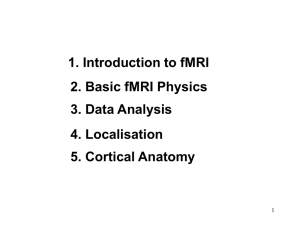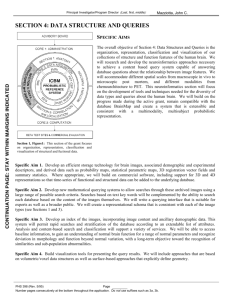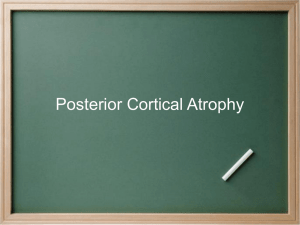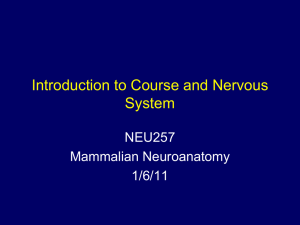Normalization - Department of Psychology
advertisement
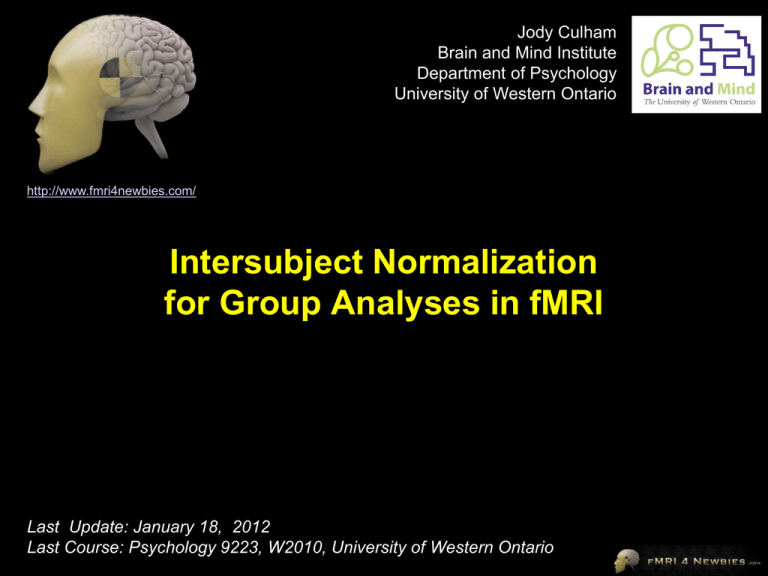
Jody Culham Brain and Mind Institute Department of Psychology University of Western Ontario http://www.fmri4newbies.com/ Intersubject Normalization for Group Analyses in fMRI Last Update: January 18, 2012 Last Course: Psychology 9223, W2010, University of Western Ontario Brains are Heterogeneous Slide from Duke course How can we define regions? Talairach coordinates • Example: The FFA is at x = 40, y = -55, z = -10 Anatomical localization • Example: The FFA is in the right fusiform gyrus at the level of the occipitotemporal junction Kanwisher, McDermott & Chun, 1997, J Neurosci Functional localization • Example: The FFA includes all voxels around the fusiform gyrus that are activated by the comparison between faces and objects Talairach Coordinate System Talairach & Tournoux, 1988 • made an atlas based on one brain … from an alcoholic old lady Note: That’s TalAIRach, not TAILarach! • any brain can be squished or stretched to fit hers and locations can be described using a 3D coordinate system (x, y, z) Rotate brain into ACPC plane Corpus Callosum Fornix Find anterior commisure (AC) Find posterior commisure (PC) ACPC line = horizontal axis Note: official Tal says to use top of AC and bottom of PC but I suspect few people actually do this Pineal Body “bent asparagus” Source: Duvernoy, 1999 Deform brain into Talairach space Mark 8 points in the brain: • anterior commisure • posterior commisure • front • back • top • bottom (of temporal lobe) • left • right Squish or stretch brain to fit in “shoebox” of Tal system y<0 AC=0 y y>0 z y>0 ACPC=0 y<0 x Extract 3 coordinates Talairach Daemon • http://www.talairach.org Talairach Tables Source: Culham et al., 2003, Exp. Brain Res. • Talairach coordinates can be useful for other people to check whether their activation foci are similar to yours • Often it’s easiest to just put coordinates in a table to avoid cluttering text Do We need a “Tarailach Atras”? Variability between Japanese and European brains, both male (red > yellow > green > blue) Variability between male and female brains, both European (red > yellow > green > blue) Source: Zilles et al., 2001, NeuroImage MNI Space • Researchers at the Montreal Neurological Institute created a better template based on a morphed average of hundreds of brains (not just one brain like Talairach) • The MNI brain is more representative of average brain shape; however, it does not provide Brodmann areas • The MNI alignment is more complex than Talairach: SPM uses it but many software packages still use Talairach • CAVEAT: The MNI and Talairach coordinate are similar but not identical -- careful comparison requires a transformation -- converters can be found online http://brainmap.org/icbm2tal/index.html Source: http://www.mrc-cbu.cam.ac.uk/personal/matthew.brett/abstracts/MNITal/mniposter.pdf Another Look at RFX Huettel, Song & McCarthy, 2008 Smoothing and Averaging Large activations across multiple subjects are more likely to show common activation than small ones --> Need to smooth (esp. for RFX analyses) UNDER CONSTRUCTION: Need to make a slide that shows this with real data Talairach Pros and Cons Advantages • widespread system • allows averaging of fMRI data between subjects • allows researchers to compare activation foci • relatively easy to use Disadvantages • not appropriate for all brains (e.g., Japanese brains don’t fit well) • activation foci can vary considerably – other landmarks like sulci may be more reliable Left is what?!!! Neurologic (i.e. sensible) convention • left is left, right is right L R - Note: Make sure you know what your magnet and software are doing before publishing left/right info! + x=0 Radiologic (i.e. stupid) convention • left is right, right is left R L + x=0 Note: If you’re really unsure which side is which, tape a vitamin E capsule to the one side of the subject’s head. It will show up on the anatomical image. (Remember which side you put it on!) Brodmann’s Areas Brodmann (1905): Based on cytoarchitectonics: study of differences in cortical layers between areas Most common delineation of cortical areas More recent schemes subdivide Brodmann’s areas into many smaller regions Monkey and human Brodmann’s areas not necessarily homologous Anatomical Localization Sulci and Gyri gray matter (dendrites & synapses) BANK white matter (axons) FISSURE FUNDUS Source: Ludwig & Klingler, 1956, in Tamraz & Comair, 2000 Variability of Sulci Source: Szikla et al., 1977, in Tamraz & Comair, 2000 Variability of Functional Areas Watson et al., 1995 - motion-selective area, MT+ (=V5) is quite variable in stereotaxic space - however, the area is quite consistent in its location relative to sulci - junction of inferior temporal sulcus and lateral occipital sulcus - see also Dumoulin et al., 2000 Cortical Surfaces segment gray-white matter boundary render cortical surface inflate cortical surface sulci = concave = dark gray gyri = convex = light gray Advantages • surfaces are topologically more accurate • alignment across sessions and experiments allows task comparisons Cortical Inflation Movie Movie: unfoldorig.mpeg http://cogsci.ucsd.edu/~sereno/unfoldorig.mpg Source: Marty Sereno’s web page Cortical Flattening 2) make cuts along the medial surface (Note, one cut typically goes along the fundus of the calcarine sulcus though in this example the cut was placed below) 1) inflate the brain 3) unfold the medial surface so the cortical surface lies flat Source: Brain Voyager Getting Started Guide 4) correct for the distortions so that the true cortical distances are preseved Spherical Averaging Future directions of fMRI: Use cortical surface mapping coordinates Inflate the brain into a sphere Use sulci and/or functional areas to match subject’s data to template Cite “latitude” & “longitude” of spherical coordinates Movie: brain2ellipse.mpeg http://cogsci.ucsd.edu/~sereno/coord1.mpg Source: Marty Sereno’s web page Source: Fischl et al., 1999 Spherical Averaging Source: MIT HST583 online course notes Learning Brain Anatomy Duvernoy, 1999, The Human Brain: Surface, Blood Supply, and Three-Dimensional Sectional Anatomy • beautiful pictures • good schematic diagrams Wanna get rich? Publish a brain atlas. • clear anatomy Sheesh, these are expensive! • slices of real brain • Springer, US$439 Ono, 1990, Atlas of the Cerebral Sulci • great for showing intersubject variability • gives probabilities of configurations and stats on sulci • Theime, US$199 Damasio,2005, Human Brain Anatomy in Computerized Images, 2nd edition • good for showing sulci across wide range of slice planes • 2nd edition much better than 1st edition • Oxford University Press, US$100 Tamraz & Comair, 2000, Atlas of Regional Anatomy of the Brain Using MRI with Functional Correlations • good overview • Springer, US$203 Talairach & Tournoux, 1988. Co-Planar Stereotaxic Atlas of the Human Brain • just because it’s the standard doesn’t mean it’s good (see also PC vs. Mac, VHS vs. betamax) • Theime, US$240


